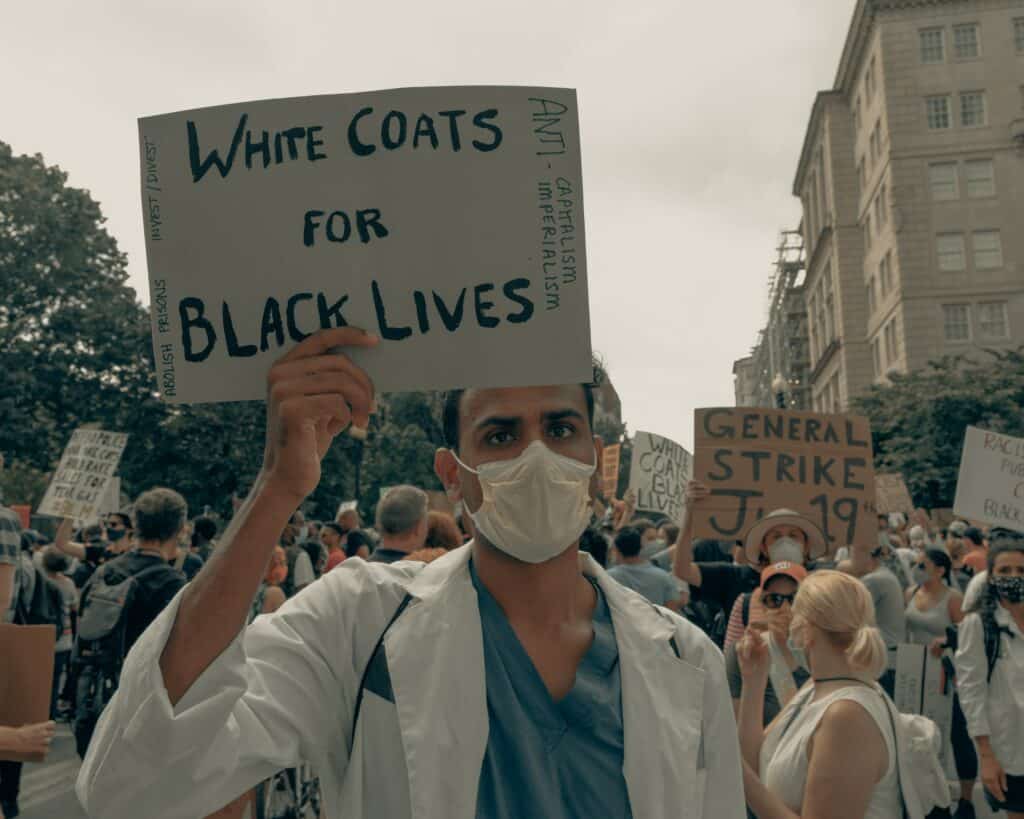The views and opinions expressed in this article are those of the authors and do not necessarily reflect the views or policy positions of NCRC.
In this article, diversity, equity and inclusion consultants Stephen Graves and Alex Bethel share insights on how White healthcare professionals can move beyond White fragility and harness their racial privilege to create health equity.
Alex Bethel
Being a cisgender White woman provides me with a lot of privilege that I can choose to hide behind. It is up to me to share that I am queer and Jewish. Having that choice is a privilege. In recent years, I dug deep into the racial inequity that exists in this country, and examined how White people can move beyond guilt to take meaningful and lasting action. In this article, Stephen and I will unpack the systemic racism in our healthcare system and highlight some actions healthcare providers can take to address it.
In 2020, people have been forced to look systemic racism in the eye and decide what side of history to be on. One only needs to look at the health inequality around COVID-19 to see how our medical systems are failing Black, Indigenious and people of color (BIPOC).
One potential explanation is that many of our frontline and essential workers are people of color. Black healthcare workers are 30% more likely than their White peers to treat someone with COVID-19. This is due to racial residential segregation. The Redlining and Neighborhood Health report published last week by NCRC highlights how COVID-19 cases are dramatically higher in segregated neighborhoods which have less access to preventative health-based resources. Historic redlining and the denial of loans and resources to people of color have created neighborhoods that are much more susceptible to COVID-19.
There are many arguments for people of color’s higher rate of exposure to the virus, yet it is also important to discuss what happens when BIPOC seek treatment for COVID-19. In this setting, racial microaggressions can mean death. Repeated verbal and behavioral discrimination can lead to distrust between the doctor and patient, which breaks down important lines of communication.
Due to restrictions in place to prevent the spread of the disease, patients suffering from COVID-19 are not allowed visitors, leaving doctors and nurses as the sole witnesses to racial inequity in the treatment of COVID-19 patients. This emphasizes the importance of peer accountability, and specifically, White practitioners holding other White practitioners to higher standards of treatment.
Stephen Graves
I am a Black man with professional experiences in healthcare administration and diversity, equity and inclusion. My lived experiences have afforded agonizing opportunities to repeatedly witness and hear stories of how loved ones, Black patients and fellow Black professionals suffer at the hands of a prejudiced health system.
In this moment of America’s reckoning with racial injustice, I have heard many well-meaning White professionals ask questions like:
- “How can I repair the broken trust with racially marginalized communities?”
- “What can I do to be a better provider for patients of color?”
- “How can I better support my Black co-workers in the clinic or on the unit?”
While there are a myriad of actions White clinical and administrative professionals should take to achieve health equity, here are a few key steps to consider:
- More White healthcare leaders should recognize and seek to heal decades of distrust between Black communities and predominately White health systems. This deep-rooted distrust, ever present amidst the ongoing COVID-19 pandemic, is well-documented, dating back to controversial studies like the Tuskegee Syphilis Experiments.
- Health professionals must commit to life-long learning and self-reflection on their racial identities and the ways implicit biases can impact how care is delivered and received.
- As Alex referenced, another important step is for White professionals to practice effective bystander intervention. White caregivers and administrators must have the courage to intentionally call out White colleagues when witnessing unfair or incivil treatment towards patients and staff of color. Examples include a White coworker interrupting a White colleague from speaking over a Black peer in meetings or a White provider addressing racist remarks directed from a patient to a Black provider.
- Lastly, health leaders and White people in positions of power must commit to diversifying their clinical and administrative teams, including their executive ranks and boards. Having a Black provider can lead to better care and outcomes for Black patients. It is imperative that health providers strive to have a leadership team and workforce reflective of the communities served. When White leaders humbly relinquish and share power, reallocate their attention and resources and defer to the lived experiences of Black professionals, trust can be regained among communities, and healing can occur at a physical, emotional and relational level.
We refer to the medical field as a practice. If White guilt will ever be turned into meaningful action as a means of achieving health equity for marginalized groups, it must be viewed the same way: as a never-ending practice.
Stephen Graves and Alex Bethel are DEI Consultants at All In Consulting.
Photo by Clay Banks on Unsplash



